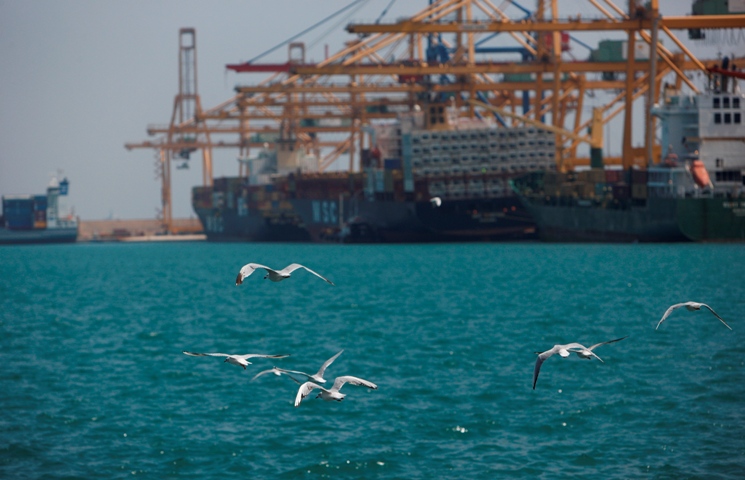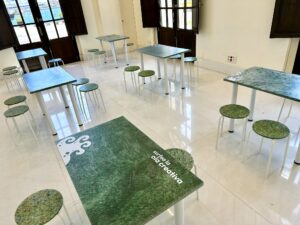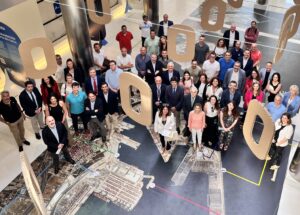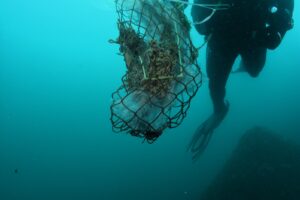 All port activities generating commercial and economic growth are regulated by the PAV’s Environmental and Energy Policy , which lays down the general environmental principles and continuous improvement objectives ensuring that port activities are respectful with the environment.
All port activities generating commercial and economic growth are regulated by the PAV’s Environmental and Energy Policy , which lays down the general environmental principles and continuous improvement objectives ensuring that port activities are respectful with the environment.
The PAV undertakes activities to ensure:
Water quality
The Port Authority of Valencia monitors and controls the water quality of its ports through:
- Daily cleaning of the water surface with a pelican-type craft.
- Regular analyses to monitor water quality, in line with Water Framework Directive requirements.
- An internal emergency plan and a contingency plan, in addition to different concession plans, to combat pollution caused by hydrocarbon spills.
Prevention and control of spills
The PAV has an Internal Emergency Plan and a Contingency Plan, plus the corresponding Emergencies Plans of all port concessions, to combat pollution caused by hydrocarbon spills.
Air quality monitoring
The PAV monitors air quality through an air quality control network made up of:
- Air quality control rooms, equipped with sensors in line with the CIEMAT (Energy, Environmental and Technological Research Centre) standard.
- Three weather stations.
- Two particle collectors.
- Computer tools that collate and manage data in real time.
Noise quality control network
The PAV monitors and controls the noise emissions produced in the port environment through:
- Predictive noise maps to assess the expected noise levels.
- Static port maps which provide empirical noise measurements.
- Sound level meters installed in the port-city interface area that measure noise in real time.
Dredging
The PAV carries out maintenance dredging to ensure access and manoeuvrability in its ports. This dredging is carried out using specially designed equipment and in line with a strict procedure that minimizes its environmental impact.
Waste management
The Port Authority of Valencia manages waste generated by vessels and concessionaires in the port facilities.
The PAV manages waste through:
- Different waste containers for separate collection.
- A hazardous waste collection point.
- A waste transfer centre.
- A reception and treatment plant for oil residues and waste generated by vessels. This service is provided by external companies.

Ongoing training of staff is also undertaken through the ECOPORT II project, in which PAV conducts an awareness campaign addressed to the Port Community aimed at achieving maximum synergy in the application of its Environmental Policy.
The PAV also collaborates with other ports and European bodies to standardise criteria and define environmental protection measures for all ports. In this context, the PAV actively participates in multiple international projects:
Projects in Progress
At present, the PAV is participating in the following R&D&I projects in the environmental sphere:
CORE LNG AS HIVE PROJECT: Core Network Corridors and Liquefied Natural Gas, financed by the CEF (Connecting Europe Facility). (2014)
SBE H2PORTS PROJECT: Implementing Fuel Cells and Hydrogen Technologies in Ports, financed by the H2020 programme through Fuel Cell and Hydrogen Joint Undertaking (FCH JU). (2019)
GREEN-C-PORTS PROJECT: Green and Connected Ports, financed by the European Commission’s Connecting Europe Facility (CEF). (2019)
https://greencportsproject.eu/
PROYECTO ECCLIPSE: Assessment of Climate Change in the Ports of South West Europe, co-financed by the European Commission through the Interreg V-B South West Europe Programme (Interreg SUDOE). (2019)
EALING – OPS PROJECT: European flagship action for cold ironing in ports, co-financed by the EU Connecting Europe Facilities (CEF) (2020)
EALING PROJECT – European flagship action for cold ironing in ports, co-financed by the EU Connecting Europe Facilities (CEF) (2020)
Projects Finished
From 1998, the PAV has participated in a number of different R&D&I projects in the environmental facility, including:
- ECOPORT PROJECT: Towards an Environmentally Friendly Port Community. (1998).
- INDAPORT PROJECT: Environmental Indicators for Ports System. (2000).
- HADA PROJECT: Automatic Environmental Diagnostics Tool. (2002).
- ECOPORT PROJECT: Information Exchange and Impact Assessment for Enhanced Environmental-Conscious Operations in European Ports and other Terminals. (2002).
- SECUR MED: Interregional and transnational vision of maritime security and defence of the environment in the Western Mediterranean. (2004).
- MADAMA: Risk management for dangerous goods traffic in the Mediterranean. (2005).
- NoMEPorts; Noise Management in the European ports. (2005).
- SIMPYC: Port and City Environmental Integration System (2005).
- ELEFSINA BAY 2020: Port-city collaboration for environmental regeneration. (2007).
- Improvement of the Environmental Management in the ports of the Gulf of Honduras. (2008).
- ECO-LOGISTYPORT: Environmental Training for. Port and Logistics SMEs in the Valencian Region. (2008).
- FICONT: Energy Efficiency in Container Port Terminals. (2009).
- CLIMEPORT: Contribution of Mediterranean ports to combat the effects of climate change. (2009).
- GREEN CRANES: Green Technologies and Eco-Efficient. (2012).
- GREENBERTH: Promotion of Port Communities SMEs role in Energy Efficiency and GREEN technologies for BERTHING operations. (2013).
- MONALISA 2.0 PROJECT: Securing the Chain by Intelligence at Sea. (2013).
- SEA TERMINALS PROJECT: Smart, Energy Efficient and Adaptive Port Terminals. (2014).CORE LNGAS HIVE PROJECT Core Network Corridors and Liquefied Natural Gas. (2014).
- GAINN4SHIP INNOVATION PROJECT: LNG Technologies and Innovation for Maritime Transport. (2015).
- GAINN4MOS PROJECT Sustainable LNG Operations for Ports and Shipping – Innovative Pilot Actions. (2015).
The PAV has a number of publications on environmental subjects, which can be consulted here.





